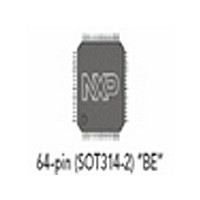SAA7111AHZ NXP Semiconductors, SAA7111AHZ Datasheet - Page 12

SAA7111AHZ
Manufacturer Part Number
SAA7111AHZ
Description
Manufacturer
NXP Semiconductors
Datasheet
1.SAA7111AHZ.pdf
(72 pages)
Specifications of SAA7111AHZ
Pin Count
64
Package Type
LQFP
Lead Free Status / RoHS Status
Compliant
Available stocks
Company
Part Number
Manufacturer
Quantity
Price
Company:
Part Number:
SAA7111AHZ
Manufacturer:
TI
Quantity:
6 710
Company:
Part Number:
SAA7111AHZ
Manufacturer:
NXP
Quantity:
34
Company:
Part Number:
SAA7111AHZ
Manufacturer:
SHARP
Quantity:
1
Company:
Part Number:
SAA7111AHZ
Manufacturer:
NXP
Quantity:
5 690
Part Number:
SAA7111AHZ
Manufacturer:
PHILIPS/飞利浦
Quantity:
20 000
Company:
Part Number:
SAA7111AHZ/V4,557
Manufacturer:
NXP Semiconductors
Quantity:
10 000
Philips Semiconductors
The output data formats are controlled via the I
OFTS0, OFTS1 and RGB888. Timing for the data stream
formats, YUV (4 : 1 : 1) (12-bit), YUV (4 : 2 : 2) (16-bit),
RGB (5, 6 and 5) (16-bit) and RGB (8, 8 and 8) (24-bit)
with an LLC2 data rate, is achieved by marking each
second positive rising edge of the clock LLC in conjunction
with CREF (clock reference) (except RGB (8, 8 and 8),
see special application in Fig.32). The higher output
signals VPO15 to VPO8 in the YUV format perform the
digital luminance signal. The lower output signals
VPO7 to VPO0 in the YUV format are the bits of the
multiplexed colour difference signals (B
The arrangement of the RGB (5, 6 and 5) and
RGB (8, 8 and 8) data stream bits on the VPO-bus is given
in Table 6.
The data stream format YUV 4 : 2 : 2 (the 8 higher output
signals VPO15 to VPO8) in LLC data rate fulfils the
CCIR-656 standard with its own timing reference code at
the start and end of each video data block.
A pixel in the format tables is the time required to transfer
a full set of samples. If 16-bit 4 : 2 : 2 format is selected
two luminance samples are transmitted in comparison to
one (B
The time frames are controlled by the HREF signal.
Fast enable is achieved by setting input FEI to LOW.
The signal is used to control fast switching on the digital
VPO-bus. HIGH on this pin forces the VPO outputs to a
high-impedance state (see Figs 18 and 19). The I
bit OEYC has to be set HIGH to use this function.
The digitized PAL, SECAM or NTSC signals AD1 (7 to 0)
and AD2 (7 to 0) are connected directly to the VPO-bus
via I
The selection of the analog input channels is controlled via
I
The upsampled 8-bit offset binary CVBS signal (VBI-data
bypass) is multiplexed under control of the I
digital VPO-bus (see Fig.8).
8.8
1998 May 15
2
C-bus subaddress 02 MODE select.
AD1 (7 to 0)
AD2 (7 to 0)
HREF: The positive slope of the HREF output signal
indicates the beginning of a new active video line.
The high period is 720 luminance samples long and is
also present during the vertical blanking.
The description of timing and position from HREF is
illustrated in Figs 15, 16, 21 and 23.
Enhanced Video Input Processor (EVIP)
2
C-bus bit VIPB = 1 and MODE = 4, 5, 6 or 7.
Reference signals HREF, VREF and CREF
Y) and one (R
VPO (15 to 8) and
VPO (7 to 0).
Y) sample within a pixel.
Y) and (R
2
C-bus to the
2
C-bus bits
2
C-bus
Y).
12
8.9
The prefiltered luminance signal is fed to the
synchronization stage. Its bandwidth is reduced to 1 MHz
in a low-pass filter. The sync pulses are sliced and fed to
the phase detectors where they are compared with the
sub-divided clock frequency. The resulting output signal is
applied to the loop filter to accumulate all phase
deviations. Internal signals (e. g. HCL and HSY) are
generated in accordance with analog front-end
requirements. The output signals HS, VS, and PLIN are
locked to the timing reference, guaranteed between the
input signal and the HREF signal, as further improvements
to the circuit may change the total processing delay. It is
therefore not recommended to use them for applications
which require absolute timing accuracy on the input
signals. The loop filter signal drives an oscillator to
generate the line frequency control signal LFCO
(see Fig.7).
8.10
The internal CGC generates all clock signals required for
the video input processor. The internal signal LFCO is a
digital-to-analog converted signal provided by the
horizontal PLL. It is the multiple of the line frequency
Internally the LFCO signal is multiplied by a factor of 2 or 4
in the PLL circuit (including phase detector, loop filtering,
VCO and frequency divider) to obtain the LLC and LLC2
output clock signals. The rectangular output clocks have
a 50% duty factor (see Fig.26).
6.75MHz
VREF: The VREF output delivers a vertical reference
signal or an inverse composite blank signal controlled
via the I
blank (COMPO)]. Furthermore four different modes of
vertical reference signals are selectable via the I
[subaddress 13, vertical reference output control
(VCTR1 and VCTR0)]. The description of VREF timing
and position is illustrated in Figs 15, 16, 24 and 25.
CREF: The CREF output delivers a clock/pixel qualifier
signal for external interfaces to synchronize to the
VPO-bus data stream.
Four different modes for the clock qualifier signal are
selectable via the I
reference output control (CCTR1 and CCTR0)].
The description of CREF timing and position is
illustrated in Figs 16, 18, 20 and 21.
Synchronization
Clock generation circuit
2
=
C-bus [subaddress 11, inverse composite
429
--------- -
432
f
H
2
C-bus [subaddress 13, clock
Product specification
SAA7111A
2
C-bus















